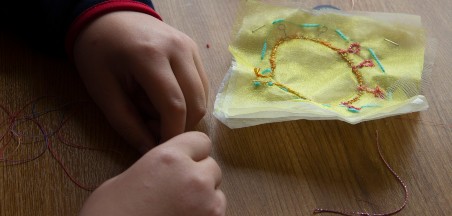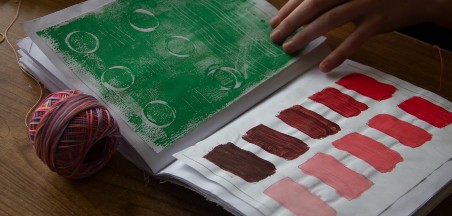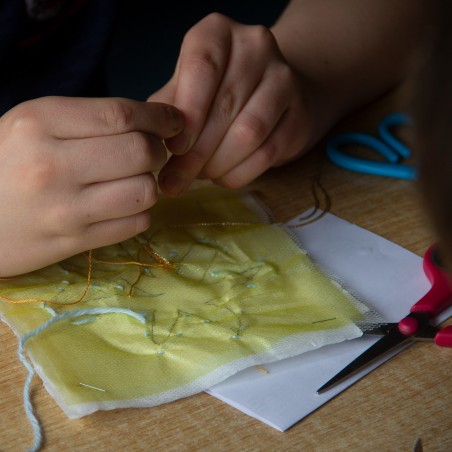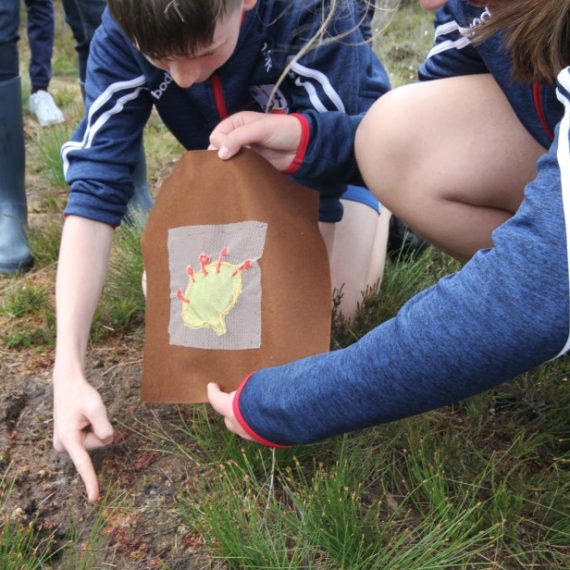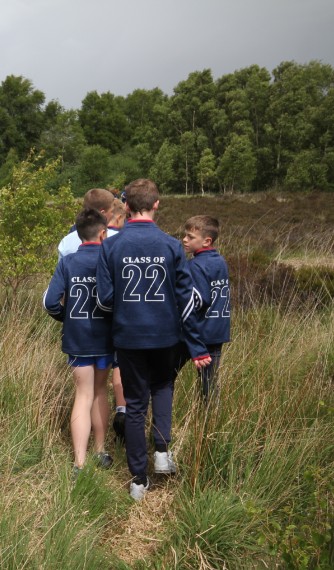Refine by Region
Refine by Art Form
Refine by School Level
Finding the Common Thread
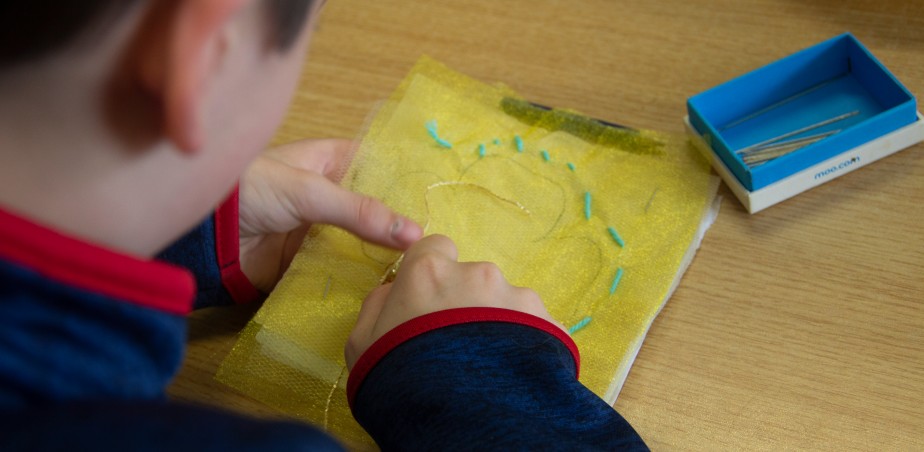
In 2022 the International Teacher-Artist Partnership (I-TAP-PD) PD Project, ‘Finding the Common Thread’ was one of the recipient’s of the Portal Documentation Award. View the project documentation video here.
Tell us the story of your project – What was the impetus? What was it about? Who was involved? How did you begin?
Breeda Kenny, Teacher
I can still hear the crackling of the lace pattern in my mother’s hands. Lacemaking was an everyday activity in my home. My mother, Eileen Mc Mahon made Carrickmacross lace for most of her life, so when Vera (artist) suggested introducing the lace making skills to my class for this particular project, I thought this would be a wonderful way to pay tribute to my mother’s creativity. I had all my mother’s lace tools, patterns and materials after she had died in 2011. I had learned to make lace as a teenager and now I wished to teach the technique to my artist partner, Vera. As it had been some time since I had made lace, I began by contacting Mary Shields, a lacemaker friend of my mother’s from the past. She kindly revised techniques with me and advised on how best to introduce Carrickmacross Lace to primary school pupils. Mary is a retired primary school teacher herself so her insights were invaluable.
Vera McEvoy, Artist
Much of my initial preparation (as artist) for the project was learning about the techniques and style of Carrickmacross Lace and practicing the lace stitches myself. There are different stages to the lace making process and a variety of stitches specific to Carrickmacross Lace which I wished to be knowledgeable on.
How were ideas developed and how did the young people, artist and teacher work together?
Breeda Kenny, Teacher
Firstly, Vera and I sat down together at my kitchen table and we planned how we would approach the lace making project. I spent the day with Vera introducing her to the basic techniques used in Carrickmacross lace. When Vera was clear on the process, we then decided together how we would modify the process to make it accessible for the pupils in Sixth Class. It was also at this point that we agreed to use coloured materials (net and organza) and not the traditional white materials. We felt this would be more appealing to the pupils.
In the classroom we had been studying “Bogs and Peatlands”. This was part of the SESE Curriculum. The children had learned about the flora and fauna of the bog. They began the project by drawing their favourite flowers and animals from the local bog. These drawings became the motifs used in the lace patterns that the pupils used to make their lace pieces. The pupils chose the pattern that they wanted to stitch and also they selected the coloured materials to match. When the sessions began in the class, all parties worked well together. The artist was very well organised and had all the materials ready for each session. There was never any delay in getting stuck into the work. Some pupils had struggled with threading the needles at first but Vera provided threaders at later sessions and this helped enormously. We modified the process for some of the pupils to make it easier for them. We did this by using different sized needles and thicker threads. We brought some of my mother’s lace pieces into the class for one of the sessions and Vera provided the pupils with white cotton gloves so they could handle and examine it carefully. The pupils loved this aspect of the project. This had been a great opportunity for conversations and the sharing of stories between artist, teacher and pupils.
The pupils were very comfortable working with the artist and teacher throughout. They looked forward to the days when Vera was coming. They were eager to start a second piece when their first piece was completed. There were marked improvements in the stitching in all of the second pieces that the pupils made. Vera’s final visit was spent with the pupils photographing the work in the actual bog landscape. The children gave a delightful spontaneous rendition of “The Bog Down in the Valley O” to Vera on that day. On returning to the school on this particular day also, the pupils enjoyed a cake that Vera had made for them. She had decorated it with icing in the style of Carrickmacross Lace, which even included a needle and thread.
What was your personal experience of the project in terms of successes and challenges?
Breeda Kenny, Teacher
This particular project was very close to my heart as the traditional craft of Carrickmacross lace was something that I had grown up with from childhood until my mother passed away in 2011. I was very happy when Vera suggested that we should try to teach the pupils the lace making skills as I felt this was a traditional craft that needed to be kept alive while at the same time we were paying tribute to my mother’s craftsmanship and her skills as a lacemaker. The engagement of the children throughout the process and their attention to my personal stories was very worthwhile and satisfying for me as a teacher. Over the years, I have found personal stories a great way to capture the attention of the pupils in my class. Story is an effective way to help pupils learn and make sense of their world. The final lace pieces stitched by the pupils are an immense source of pride for me. They are beautiful. Some pupils have the potential to make lace to a very high standard in the future if they decide to do so. All pupils have an appreciation of the quality of true craftsmanship. I know my mother would have loved to have been part of this project.
Our joint decision to exhibit the children’s work in the local Heritage Centre will be an opportunity to disseminate the good work in the local community and I know that the pupils are very excited by this forthcoming event.
Like all activities in schools nowadays, time management presents as one of the greatest challenges. It would have been great to develop the project to include more stitches and techniques if not for time constraints. Due to the intricacies of the lace making techniques, it was challenging and tiring to get around to all the pupils to help them with difficulties they were experiencing. It is probably fair to say we were both exhausted at the end of each session.
Vera McEvoy, Artist
Working in TAP (Teacher-Artist Partnership) with Breeda is of enormous benefit to the project, the pupils and me as the artist on the project. There is a sense that everything about the project is shared. We were introducing specific skills in a primary class context which neither of us had done before. The trust and honesty which has developed in our relationship over the years has helped hugely during the project. If things were not working out as we had planned and we needed to change direction, this was never a problem. This support allows me as an artist to be more confident in spending time on the process, without focusing on a final outcome. The partnership which we have built over time has continued to grow and develop greatly. The partnership models examples of trust, confidence, collaboration and teamwork to the pupils also.
My personal experience of the project in terms of successes and challenges; I have learned a lot about Carrickmacross lace techniques and it’s heritage. I had no knowledge of it prior to this project. While I have good skills with a needle and thread, Breeda was very generous with her time during our initial meeting in showing me the relevant stitches necessary. I really enjoyed making the test pieces with Breeda in her home, chatting and laughing as we sewed.
As the project progressed, I specifically remember trying to take a shortcut on the basic tacking stitches, with a small group of pupils, which wasn’t really working out successfully. It was clearly evident that we needed to take a step back and do the task as originally planned. Breeda and I chatted about it together, with the students. We all agreed that we needed to go back and do it as it should have been done. This was a great learning experience for the students, both to see and hear us discussing the challenge and the different options, to see that in some cases shortcuts just don’t work.
What was significant for you about the project that is worth sharing?
Breeda Kenny, Teacher
For me, surprisingly the stories that evolved during the sessions became a significant part of the project. While working on the lace-making skills, I felt I was giving the children an insight into my own life and the relationship that I had shared with my mother because of her creativity. I wanted the children to see the value of family and the people closest to us as our primary educators. Learning doesn’t just happen in school. The lived experience of home and family is a very important part of lifelong learning.
The pupils’ examination of the intricate lace pieces was a particular time that I will remember about the project. One of the pieces that we showed them was the christening robe that my mother had made for my sons. They were fascinated by this and spent time trying to find my son’s initials which had been secretly sewn into the robe by my mother. Here, the pupils were connecting with my personal story in a very real way.
During the project, I became aware of the need for the pupils to be exposed to rich artistic experiences like lace making. Many of the pupils in my class would have had limited access to various art forms. Few would have experienced sewing or knitting in their lives. We need to bring these types of crafts and skills back into the class as they are an integral part of our heritage. We need to develop the pupils’ appreciation of the wide spectrum of arts available.
The focus displayed by pupils while stitching their pieces will be something that will stay with me. The silence in the classroom at times was incredible. Stitching had brought mindfulness and the art of being mindful into the classroom setting in a very natural and uncontrived way. The pupils had become lost in their work.
Visits to the outdoors and being in the open space are really worthwhile for the pupils. The bog in particular is a space of immense natural beauty. But it is more than this. It is a place of calmness, a sensual place, a place with no distractions, a timeless place, a place of complete focus, a restorative place, a place for reflection, a spiritual place.
Vera McEvoy, Artist
There are many significant things about this project that stand out for me: the children’s broad understanding of creativity, their expression of joy as their sewing skills improved, their problem solving skills as they gained confidence in their new skills.
At the start of the project Breeda and I discussed the 5 Creative Habits of Mind* with the pupils. Their broad understanding of what creativity is, was so inspiring. They highlighted areas in school, at home, in sports and many more areas where people and their peers are being creative.
Each week, we discussed the 5 habits; skill/discipline, imagination, persistence, inquisitiveness and collaboration. We encouraged the pupils to think about the 5 competencies in relation to their specific sewing skills and their creative confidence generally. One boy was so delighted with his progress, he said with a wide smile on his face “My sewing was a disaster at the start”.
As sewing skills developed, the pupils’ preference for specific threads or specific style of needles was evidence of their understanding of how best to achieve their desired stitch result. This understanding of the ‘tools’ for sewing only comes with practice and experience.
Has anything changed in your work as a result of the project?
Breeda Kenny, Teacher
Pupils in general have little exposure to the skills of sewing . The pupils in my class this year had had little or no experience of stitching or sewing. I have seen the value of needlework with the children. Throughout the year, I had introduced them to some basic skills so by the time the lace project started, they had some idea how to thread the needle, knot the thread and do some basic stitches. Stitching is excellent for the development of fine motor skills in particular. It refines the use of the small muscles which control the hand, fingers and thumb which are essential for performing life long skills.
Working on the lace pieces, the pupils became very focused. They seemed to get lost in the activity and were undistracted. This was a great way to experience mindfulness at work in the classroom. Needlework will become an important part of my practice in the future.
I hope to develop this project further with my classes in the future.
Vera McEvoy, Artist
I have increased my teaching skills further while watching and working with Breeda and her engagement with the students. My awareness of the knowledge and skills required by teachers, alongside their day to day challenges is heightened. These insights help me to understand how I as an artist can work more effectively in partnership with teachers. It also increases my understanding of the Primary School Curriculum.
Breeda’s speedy organisation of the room into small groups and task areas is amazing as it can change the efficiency and the dynamic of the lesson instantly. It is really helpful for me to be part of this creative versatility and to experience its benefits first hand. Being flexible, changing direction, taking breaks, moving students, intervening for the benefit of successful teaching and interaction, keeping the children interested, asking higher order and thought provoking questions, are wonderful for me as an artist to experience and witness.
Spotlight
Artist(s):
Artist Vera McEvoy
Vera McEvoy is a Celbridge based artist and a graduate of the National College of Art and Design Dublin. Her practice is participatory and collaborative, working with all ages to encourage art in everyday living; to see, to reflect and to create. She also has a solo practice and has exhibited nationally and internationally since 2007.
Vera has been involved in the Teacher-Artist Partnership (TAP) programme since 2015 and has worked in partnership with Breeda since 2016.
Vera is the current Artist in Residence, Froebel Department of Primary and Early Childhood Education, Maynooth University. Young People, Children and Education Residency, the Arts Council of Ireland.
Recent project: BLAST* in St Joseph’s Mercy Secondary School, Navan, Co Meath. This was a glass fusing project, read more on veramcevoy.com/blast-2022/
Teacher(s):
Teacher Breeda Kenny
Breeda Kenny is a teacher in St Kilian’s NS Mullagh Co.Cavan. She is the Vice-principal of the school and currently teaches 6th Class.
She is a graduate of Mary Immaculate College of Education and she completed an M.Sc in Education and Training in DCU in 2013. The title of the dissertation was “How can I demonstrate the importance of the Creative Arts in my practice as a primary school teacher through the medium of video?
Breeda has attended, designed and delivered many professional development courses on aspects of the primary curriculum. She designed and delivered music courses for primary school teachers in conjunction with the Monaghan Education Centre. She became involved in the Teacher-Artist Partnership (TAP) initiative back in 2016 and has since worked in partnership with Vera McEvoy as facilitators for Navan Education Centre.
Other:
(Curator, agency, etc):
Erasmus+ International Teacher-Artist Partnership
International Teacher-Artist Partnership (I-TAP-PD) PD is an exciting project which focuses on enabling teachers and artists to jointly develop their understanding, expertise and creativity in ‘arts in education’ work with children and young people in education, community and arts settings. It offers a unique opportunity for teachers and artists to explore the nature and educational value of partnerships in supporting arts education in early and Primary school education.
The ultimate aim of Erasmus+ I-TAP-PD is to create innovative professional development (PD) opportunities, innovative intellectual outputs and resources to enable both teachers and artists to challenge, develop and potentially transform their practices for the benefit of the children they teach and the school communities in which they work at a trans-European level and beyond. The enhanced practices that will emerge as a result of this collaboration will be the subject of fresh international research and innovation.
For further information go to i-tap-pd.net/

Artist(s)
Vera McEvoy

Teacher(s)
Breeda Kenny
Artforms
School/
Participant Group
St Kilians NS Mullagh, Co. Cavan
No. Participants
26
Region
Age/Class
6th Class
Dates
January 2022 – June 2022
Leading Agency
Erasmus+ International Teacher-Artist Partnership PD
Key themes/ lines of enquiry
Theme: Our local bog, Killyconny
Aim: Introduce Carrickmacross Lace making skills, with a contemporary twist, in the style of local award winning artist Eileen Mc Mahon (1936 -2011)
Curriculum Strands
Visual Art - Fibre art, English, Science, History, Geography and SPHE
Research or relevant publications
We explored historical and contemporary Carrickmacross lace. The children got to examine and touch lacework by Eileen Mc Mahon
There are many significant things about this project that stand out for me: the children's broad understanding of creativity, their expression of joy as their sewing skills improved, their problem solving skills as they gained confidence in their new skills.
Vera McEvoy, Artist
